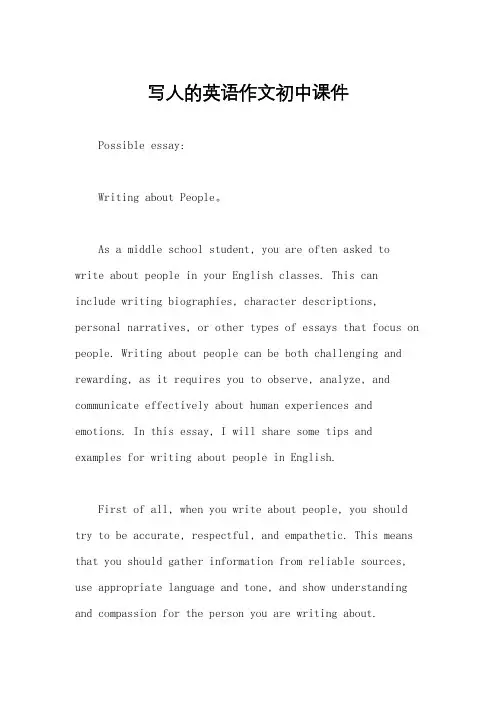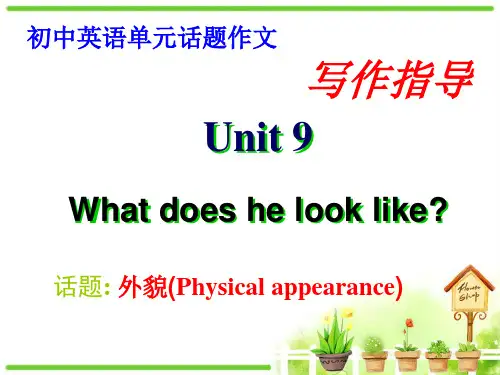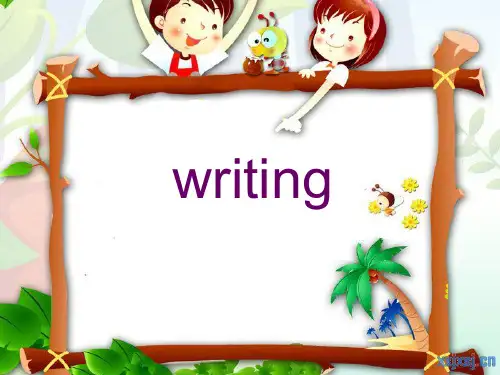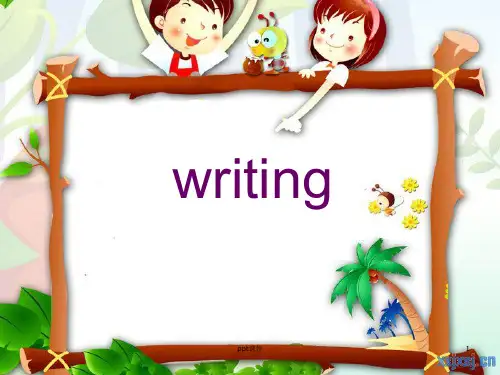初中英语写作课件
- 格式:ppt
- 大小:469.00 KB
- 文档页数:15

写人的英语作文初中课件Possible essay:Writing about People。
As a middle school student, you are often asked towrite about people in your English classes. This can include writing biographies, character descriptions, personal narratives, or other types of essays that focus on people. Writing about people can be both challenging and rewarding, as it requires you to observe, analyze, and communicate effectively about human experiences and emotions. In this essay, I will share some tips and examples for writing about people in English.First of all, when you write about people, you should try to be accurate, respectful, and empathetic. This means that you should gather information from reliable sources, use appropriate language and tone, and show understanding and compassion for the person you are writing about.Whether you are writing about a famous historical figure, a family member, a friend, or a stranger, you should aim to present a balanced and nuanced portrait of their life, personality, and achievements.For example, if you are writing a biography of a scientist, you might start by researching their background, education, and career. You could then highlight some of their major discoveries, inventions, or contributions to their field. You could also discuss their personal life, such as their family, hobbies, or challenges. To make your biography more engaging and informative, you could include quotes from the person's own words or from people who knew them well. You could also use images, videos, or other multimedia resources to illustrate your points and provide context.Another type of writing about people is character description. This involves portraying a fictional or real person in a story or a play. To write a good character description, you should pay attention to their appearance, behavior, speech, thoughts, and feelings. You should alsoconsider their role in the plot, their relationships with other characters, and their motivations and conflicts. By creating a vivid and believable character, you can help your readers to connect with the story and to understandits themes and messages.For instance, if you are writing a personal narrative about a memorable event in your life, you might describe the people who were involved in it. You could use sensory details to bring them to life, such as their facial expressions, gestures, or voices. You could also reveal their personalities and emotions through their actions, words, or thoughts. By showing how these people affected you and how you interacted with them, you can convey the significance of the event and its impact on your growth and development.In conclusion, writing about people is an importantskill that can enhance your communication, critical thinking, and creativity. By learning how to write biographies, character descriptions, personal narratives, and other types of essays about people, you can broadenyour knowledge, empathy, and appreciation of human diversity and complexity. Whether you are writing for school, for work, or for pleasure, you should strive to write with clarity, accuracy, and sensitivity, and to engage your readers with compelling stories and insights.。










初中英语作文写作课优秀课件目录CATALOGUE •Course Introduction andObjectives•Fundamentals of Writing•Writing skills and methods•Common Theme WritingGuidelines•Appreciation and Analysis ofMasterpieces•Writing training andimprovement01CATALOGUECourse Introduction andObjectivesThe Importance of Middle School English Composition•Improving students' comprehensive English proficiency: Throughwriting training, students can better grasp language elements such asvocabulary, grammar, and sentence structures, and improve theiroverall English proficiency.•Developing students' cross-cultural communication skills: Englishwriting is one of the important means of cross-culturalcommunication. Through writing training, students can betterunderstand the culture and thinking patterns of English speakingcountries, and improve their cross-cultural communication abilities.•To lay a foundation for students' future learning and work: GoodEnglish writing ability is an important foundation for students' futurelearning and work, which can provide more opportunities for theirfurther education and career development.Course objectives and requirementsKnowledge objectiveTo master the basic knowledge and skills of English writing, including writing process, article structure,paragraph development, sentence structure changes, etc.Ability objectiveTo independently complete an English article with clear structure, rigorous logic, and fluent language, andpossess certain critical thinking and innovative abilities.Emotional goalTo cultivate students' interest and enthusiasm for English writing, improve their self-learningability and collaborative spirit.Course arrangement and scheduleCourse arrangementThis course is divided into 10 class hours, each lasting 45 minutes. The coursecontent includes explanation of basic writing knowledge, analysis of sampleessays, writing practice, and homework review.Class timeOnce a week, the specific time will be arranged according to the student'sschedule and actual situation.Teaching methodAdopting a combination of online and offline methods, providing coursewareand teaching videos online, and conducting face-to-face tutoring and Q&Aoffline.02CATALOGUE Fundamentals of WritingVocabulary accumulation and application•Positive vocabulary and negative vocabulary: Positive vocabulary refersto words that can directly express the author's intention in the article,while negative vocabulary refers to words that cannot directly expressthe intention but can increase the richness and readability of thearticle.•Semantic analysis and accurate word usage: In English, many wordshave similar meanings, but their usage scenarios and contexts aredifferent. Therefore, when writing, it is important to pay attention toword meaning analysis and choose the most accurate vocabulary toexpress one's thoughts.•Phrases and idioms: There are many fixed phrases and idioms inEnglish, and mastering these expressions can make the article moreauthentic and natural.Sentence Structure and Changes•Simple sentences, compound sentences, and compound sentences:Simple sentences only contain one subject and one predicate; Parallelsentences are composed of two or more simple sentences connectedby parallel conjunctions; A compound sentence contains a main clauseand one or more subordinate clauses.•Sentence pattern transformation and expansion: Through sentencepattern transformation, declarative sentences can be transformed intointerrogative sentences, exclamation sentences, etc., increasing thediversity and expressive power of the article. At the same time,sentence components can also be expanded, such as addingattributives, adverbials, etc., to make the sentence more specific andvivid.There are multiple tenses and voices in English, and using them correctly can make the article more accurate and fluent.The subject and predicate mustbe consistent in person andnumber, otherwise it will lead togrammar errors.Articles, pronouns, andprepositions play importantconnecting roles in English. Usingthese vocabulary correctly canmake the article more coherentand clear. Meanwhile, it is alsoimportant to avoid commonusage errors.Tense and voice Subject verbconsistency Articles, pronouns, and prepositionsGrammar rules and common errors03CATALOGUEWriting skills and methods03Conceptual contentBased on the theme, develop associations, and conceptualize the content and key points of the article.01Carefully review the questioncarefully read the question, understand its meaning, and clarify the writing requirements and limitations.02Determine the themeBased on the requirements of the title, determine the theme and central idea of the article.Topic review and conceptionArticle structure and layoutReasonably arrange paragraphs01Based on the content of the article, arrange paragraphsreasonably to make the article clear in hierarchy.Highlight topic sentences02Set topic sentences at the beginning or end of each paragraphto clarify the central idea of the paragraph.Pay attention to transitions03Use transitional words or phrases between paragraphs to makethe article coherent and natural.Language expression and rhetoric•Accurate wording: Choose appropriate vocabulary to express ideasand avoid using obscure or overly simple words.•Diverse sentence structures: Use different sentence structures toexpress ideas, such as simple sentences, compound sentences, etc., toenhance the expressive power of the article.•Using rhetoric: Use appropriate rhetorical devices such as metaphors,personification, and parallelism to make the article more vivid andvivid.•Pay attention to grammar and spelling: avoid grammar and spellingerrors, and maintain the accuracy and standardization of the article.04CATALOGUE Common Theme WritingGuidelinesNarrative Writing•Select a theme and plot: Choose an interesting story theme and planthe plot development, including the cause, process, and outcome.•Shaping character images: By describing the appearance, personality,behavior, and other aspects of characters, vivid character images arecreated.•Pay attention to detail description: Use vivid details to help readersbetter understand and feel the story context.•Reasonable arrangement of narrative sequence: Different narrativemethods such as sequential, reverse, or interlude can be used to makethe story more engaging.Choose a familiar objectof explanation, such as an object, event,phenomenon, etc., and provide a detailedintroduction and explanation.Clearlyexplain the objectCollect and explain information andinformation related to the target through channels such as books and theinternet.Collect relevant informationOrganize the content ofthe article in an organized manner according to differentexplanation orders suchas time order, spatial order, or logical order.Arrange explanation orderUsing different methodssuch as definition,classification, comparison, and examples to make the article moreaccessible and understandable.Usingexplanatory methodsExpository writingargumentative writing•Identify arguments and evidence: Choose a controversial topic, clarifyyour viewpoint and stance, and prepare supporting evidence tosupport the argument.•Reasonable arrangement of argumentation structure: Differentargumentation structures such as total score, listing themes, andfinding several parallel viewpoints to discuss the themes can be usedto make the article clear and organized.•Using argumentation methods: using different argumentationmethods such as factual argumentation, rational argumentation, andcomparative argumentation to enhance the persuasiveness of thearticle.•Pay attention to language use: Use accurate and concise language toexpress opinions, and avoid using words that are too absolute orvague.05CATALOGUE Appreciation and Analysis of MasterpiecesExhibition of excellent works by studentsWork 1"My Favorite Teacher"Work 2A Memorable DayWork 3"The Power of Friendship"Teacher comments and suggestions•Comment on work one: The article has a clear structure and fluentlanguage, showcasing the excellent qualities of the teacher throughspecific examples, expressing the author's love and gratitude towardsthe teacher. Suggest adding some detailed descriptions to make thecharacter image more vivid.•Commentary on Work 2: The article features novel material selectionand vivid narration, showcasing the author's love and optimisticattitude towards life by recounting interesting events that happenedduring the day. Suggest refining the language expression to enhancethe infectiousness of the article.•Comment on work three: The article has a profound meaning and clearviewpoint. By discussing the power of friendship, it expresses theauthor's appreciation and admiration for friendship. It is suggested toadd some specific examples during the argumentation process tomake the viewpoint more convincing.Interactive session: Student self-evaluation and peer evaluation•Self evaluation: I believe that I have a certain foundation in writing andcan express my thoughts fluently. But there is still room forimprovement in the selection of materials and ideas, and moreattention needs to be paid to observing and thinking about life.•Mutual evaluation one: I think his works have concise language andclear expression, but there are still shortcomings in detail descriptionand emotional expression. I hope he can pay more attention to detailsand emotional presentation in his writing.•Mutual evaluation two: I think her works have novel material selectionand unique perspectives, but in the process of argumentation, thereare some that are too simplistic and one-sided. I hope she can addsome specific examples and data support in the argument to make theviewpoint more convincing.06CATALOGUE Writing training and improvementClassroom timed writing exercisesStrictly set the timein a simulated exam environment, students are required to complete theiressays within the specified time.Diversity of topic selectionProvide different types of questions to expose students to and practice variousgenres and themes.On the spot reviewProvide real-time feedback on students' compositions, pointing out theirstrengths and weaknesses, and providing suggestions for improvement.Suggestions for independent training after classPersist in writingEncourage students to develop the habit of writingevery day, such as writing diaries, weekly notes, oressays.Expand readingRecommend English original works or articlessuitable for middle school students to read, broadentheir horizons, and accumulate materials.Reflection and revisionGuide students to reflect and revise their owncompositions, and improve their self correctionability.RegularassessmentConduct a formal writing assessment at regular intervals to assess students' learning outcomes.PersonalizedfeedbackProvide specific feedback andsuggestions for each student'sessay to help them identify theirshortcomings.Display andCommunicationSelect excellent compositions fordisplay and communication,allowing students to learn fromeach other and progress together.010203 Regular evaluation and feedbackTHANKS感谢观看。